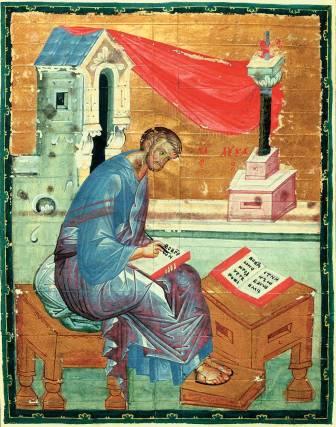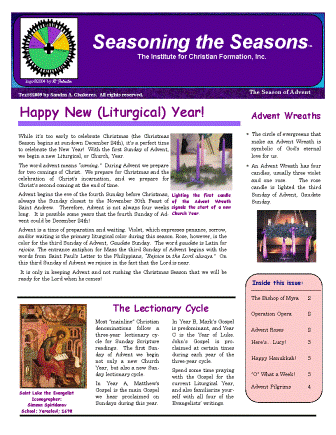The Institute for Christian Formation
Follow us on Facebook to keep up to date with our news and newest resources!
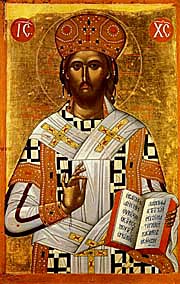
First Sunday of Advent
November 29, 2015
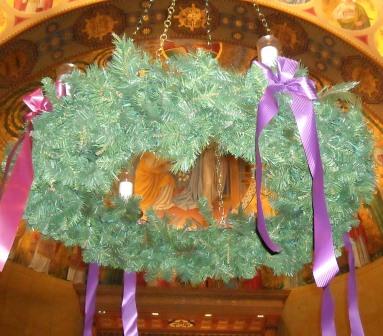
The word “advent” means "coming". The Church teaches us that during Advent we wait for two comings of Christ: we prepare to celebrate Christmas, when Christ first came into the world; and, we wait for Christ’s second coming at the end of time. (See General Norms for the Liturgical Year and Calendar, Paragraph 39, from Documents on the Liturgy, 1963-1979, Conciliar, Papal and Curial Texts © 1982, ICEL.)
Advent begins at sundown the eve of the fourth Sunday before Christmas and concludes at sundown on Christmas Eve. The
First Sunday of Advent also heralds the beginning of the new Church Year, or Liturgical Year.
Advent is a time of preparation and waiting. Violet, which expresses penance and/or waiting, is the primary liturgical color during this season. Rose, however, is the color for the third Sunday of Advent, Gaudete Sunday.
As Catholic Christians, we are called to reject the secular, commercial culture of already celebrating Christmas, and to faithfully keep the season of Advent until sundown Christmas Eve, when the Christmas Season begins. We keep Advent in many ways in our homes: the family Advent Wreath, the Jesse Tree, the O Antiphons (December 17-23). We celebrate special Advent Feast Days, such as the feast of Saint Nicholas (December 6), the Solemnity of the Immaculate Conception (December 8, the Feast of Our Lady of Guadalupe (December 12), and the feast of St. Lucy (December 13).
It is only in keeping Advent and not rushing the Christmas Season that we will be ready for the Lord when He comes!
Click on image above to download our 4-page ICF bulletin on the Advent Season.
On this first Sunday of Advent, make an Advent Wreath for your home. Gather some fresh evergreen trimming, four candles (three violet and one rose colored), and an Advent Wreath ring/form. Visit your local Catholic Supply store or hobby/craft shop to purchase the wreath ring and candles. You can also purchase wreath rings and candles on line from sources such as Autom. (Autom sells these items in packs of six, not individually.)
You can also use other items to decorate your Advent Wreath. For example, I tie violet and rose ribbons around the base of each candle in my wreath. Triple Oaks Nursery has some interesting suggestions as to fresh herbs to add to your wreath, full of symbolism.
Once your wreath is assembled, celebrate a Blessing of your Advent Wreath and light the first violet candle.
"O Come, O Come, Emmanuel" is a wonderful Advent hymn to sing as you light your Advent Wreath each day of Advent. You can download the words and music to this hymn here.
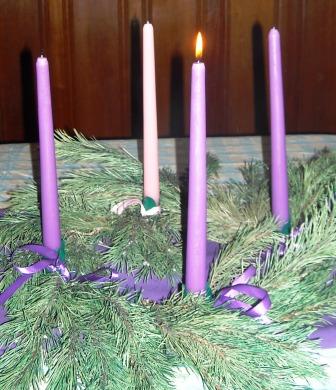
Did you know you can access the Scripture readings assigned to every day of the Church Year at the United States Conference of Catholic Bishops' web site? Click here.
Another family project for today could be making an Advent calendar. Advent calendars and Advent houses let you count down the days until Christmas Day. This page contains a template from the Ohio Department of Education, and here you can find one from Kodak. But instead of having treats or surprises for children for each day, create your Advent calendar/house so that the children are also opening each window or door to find either a reference to a Scripture passage they can read (or you can read to them), or a suggestion for a good deed they can do today.
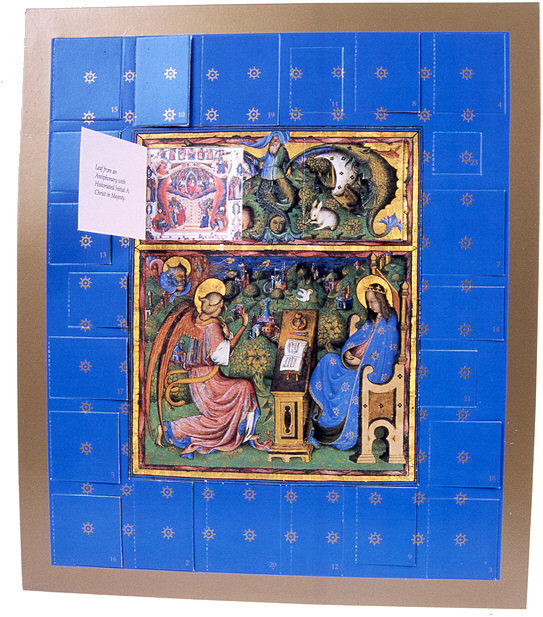
There are numerous sources for Advent calendars, if you choose to purchase one. Choose one with a religious theme, rather than a secular theme. Liturgy Training Publications has a fantastic Advent/Christmas Calendar that begins the First Sunday of Advent and continues through the Christmas Season, as well. A prayer book for each day accompanies your purchase. This is a wonderful addition to your home and/or classroom.

Begin to prepare a manger for Jesus today, too. Put up your empty “stable” in your home or classroom. For every good deed done between now and December 24, put a piece of straw in the stable so that on Christmas, you will have a place prepared for the Christ Child.
Lectionary Cycle C - The Year of Luke
The First Sunday of Advent is not only the beginning of a new liturgical year, but it also signals the beginning of a new lectionary cycle - the cycle of readings. This year our Sunday Cycle is Year C - The Gospel of Saint Luke, and our Weekday Cycle is Cycle II. You can access today's readings here.
Luke’s Gospel has some wonderful stories that we do not find in the other Gospels. For example, it is only in Luke’s Gospel that we find the Annunciation story, which tells us about the Archangel Gabriel visiting Mary and telling her she had been chosen to be the mother of Jesus. This is not the only story unique to Luke’s Gospel. For example, the story of the announcement of the birth of John the Baptist, as well as the story of his birth, are unique to Luke’s Gospel. And the famous parables of the Good Samaritan and the Prodigal Son are only found in the Gospel of Luke!
St. Luke the Evangelist
Andrei Rublev, circa 1400
Russian State Library, Moscow
Happy New Liturgical Year!
Luke’s Gospel is also important to the prayer and devotional life of the Church in other ways. The canticles prayed in the “official” daily prayer of the Church, the Liturgy of the Hours, are only found in Luke’s Gospel. At Morning Prayer we sing the Benedictus (the Canticle of Zechariah found in Luke 1:68-79). The Magnificat (the Canticle of Mary found in Luke 1:46-55) is sung each day at Vespers, or Evening Prayer. And the Canticle of Simeon (Luke 2:29-32) is sung each day at Compline, or Night Prayer.
Luke’s Gospel is also central to the devotion of the rosary. Did you know, for example, that of the first five mysteries of the rosary - the Joyful Mysteries - four of these (the Annunciation, the Visitation, the Presentation of the Child Jesus in the Temple, and the Finding of the Child Jesus in the Temple) are stories only found in the Gospel of Luke? (Accounts of the Nativity of Jesus, the third Joyful Mystery of the Rosary, are found in two Gospels - Matthew and Luke - but are two totally different accounts of the birth of Jesus.)
The Temple is very important in Luke’s Gospel. In fact, his Gospel both begins and ends in the Temple. Hence the symbols of an ox, or bull/cow, for Luke - as this was an animal sacrificed in the Temple!
The Acts of the Apostles is also attributed to Saint Luke, and is in a sense a sequel to the Gospel of Luke. Saint Luke's feast day is October 18. He is the patron of the medical profession, painters, artists, sculptors, and butchers.
You can find more about the Lectionary and the Scriptures used during Mass here.
